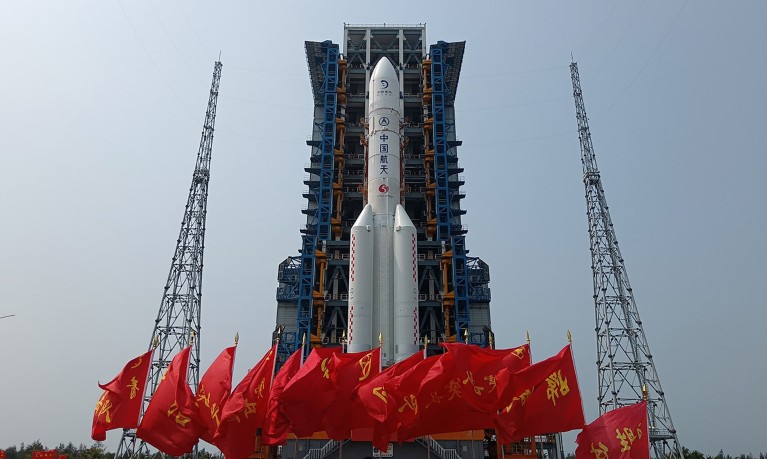[ad_1]

Onboard this Long March 5 rocket, Chang’e-6 is waiting to lift off from the Wenchang Space Launch Centre on Hainan Island, southern China.Credit: Xinhua/Shutterstock
China has successfully launched its historic Chang’e-6 mission.The 53-day odyssey will be the most complex and challenging Moon mission China has carried out. If all goes according to plan, scientists will be examining the first rocks from the Moon’s far side by late June.
The 7.2-metre-tall, eight-tonne spacecraft lifted off aboard a Long March 5 rocket on Friday afternoon local time, piercing through a tropical rainstorm from the Wenchang Satellite Launch Centre on Hainan Island. Just over one hour into the flight, the China National Space Administration (CNSA) announced the launch “a complete success”, after the craft separated from the rocket and entered the designated Earth-Moon transfer orbit.
Quentin Parker, an astrophysicist at the University of Hong Kong, hails the launch as “flawless”. “China’s accomplishments in space exploration over the past few years are without precedent. If successful, this mission will be another science bonanza,” he says.
Two-faced Moon
The lunar far side, which always faces away from us because the Moon is tidally locked to Earth, could not be more different than its near side, says planetary scientist Bradley Jolliff at Washington University in St Louis. Most of the ancient volcanic activity on the Moon happened on the near side, while the far side remained quieter under a thick and heavily cratered crust. “You would hardly know that they are from the same body by comparing the two sides,” Jolliff says.
What China’s mission to collect rocks from the Moon’s far side could reveal
A total of 10 missions, manned or unmanned, have brought back Moon rocks for analysis — all from the near side. Landing on the Moon’s far side requires, among other things, a communications satellite to relay signals with Earth.
This is why China launched the Queqiao-2 satellite in March, which is equipped with a 4.2-metre-diameter radio antenna — the largest of its kind used in deep space exploration — to orbit the Moon and wait for the arrival of Chang’e-6.
After arriving at the Moon early this week, the spacecraft will gradually lower its orbit and prepare for landing in one of three pre-selected areas within the South Pole-Aitken basin (SPA). The SPA is the largest and oldest impact basin on the lunar surface, and samples from there will provide clues to the Moon’s two-face mystery and the early history of the solar system.
In early June, the spacecraft will drop a lander, which aims to drill and scoop up two kilograms of soil and rocks. Then an ascender will blast off from the lander and ferry the samples back to the orbiter for the trip back home. Thanks to Queqiao-2, the spacecraft and Earth will remain in contact during the mission’s critical moments, such as the 15-minute descent and touchdown, two-day sampling, and 6-minute ascent.
“The geological conditions on the far side are less clear. Whether we’ll actually be able to scoop up or drill down, all remains to be seen when the sampling begins,” Pei Zhaoyu, a senior CNSA official and chief designer of China’s upcoming Chang’e-8 mission, told China Central Television during the launch livestream.
Scientists hope Chang’e-6 will also return material from beyond its landing site, such as rock fragments thrown over to the landing site from far distant locations during powerful impacts, Jolliff says. The material collected at the Chang’e-6 site “will be like a treasure chest”, he says. “The samples collected will be analysed for decades to come, and hopefully with access provided to the international research community,” he says.
Chang’e-6 is expected to return to Earth around June 25. If successful, the precious samples will land at the Siziwang Banner Landing Site in Inner Mongolia and be retrieved within 48 hours, according to CNSA.
[ad_2]
Source Article Link


